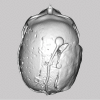Craniofacial Reconstruction by a Cost-Efficient Template-Based Process Using 3D Printing
- PMID: 29263977
- PMCID: PMC5732683
- DOI: 10.1097/GOX.0000000000001582
Craniofacial Reconstruction by a Cost-Efficient Template-Based Process Using 3D Printing
Abstract
Craniofacial defects often result in aesthetic and functional deficits, which affect the patient's psyche and wellbeing. Patient-specific implants remain the optimal solution, but their use is limited or impractical due to their high costs. This article describes a fast and cost-efficient workflow of in-house manufactured patient-specific implants for craniofacial reconstruction and cranioplasty. As a proof of concept, we present a case of reconstruction of a craniofacial defect with involvement of the supraorbital rim. The following hybrid manufacturing process combines additive manufacturing with silicone molding and an intraoperative, manual fabrication process. A computer-aided design template is 3D printed from thermoplastics by a fused deposition modeling 3D printer and then silicone molded manually. After sterilization of the patient-specific mold, it is used intraoperatively to produce an implant from polymethylmethacrylate. Due to the combination of these 2 straightforward processes, the procedure can be kept very simple, and no advanced equipment is needed, resulting in minimal financial expenses. The whole fabrication of the mold is performed within approximately 2 hours depending on the template's size and volume. This reliable technique is easy to adopt and suitable for every health facility, especially those with limited financial resources in less privileged countries, enabling many more patients to profit from patient-specific treatment.
Figures






Similar articles
-
Accuracy Assessment of Molded, Patient-Specific Polymethylmethacrylate Craniofacial Implants Compared to Their 3D Printed Originals.J Clin Med. 2020 Mar 19;9(3):832. doi: 10.3390/jcm9030832. J Clin Med. 2020. PMID: 32204321 Free PMC article.
-
The feasibility of producing patient-specific acrylic cranioplasty implants with a low-cost 3D printer.J Neurosurg. 2016 May;124(5):1531-7. doi: 10.3171/2015.5.JNS15119. Epub 2015 Nov 13. J Neurosurg. 2016. PMID: 26566203
-
Customized alloplastic cranioplasty of large bone defects by 3D-printed prefabricated mold template after posttraumatic decompressive craniectomy: A technical note.Surg Neurol Int. 2022 Apr 22;13:169. doi: 10.25259/SNI_1239_2021. eCollection 2022. Surg Neurol Int. 2022. PMID: 35509538 Free PMC article.
-
3D-printed patient-specific applications in orthopedics.Orthop Res Rev. 2016 Oct 14;8:57-66. doi: 10.2147/ORR.S99614. eCollection 2016. Orthop Res Rev. 2016. PMID: 30774470 Free PMC article. Review.
-
Emerging Applications of Bedside 3D Printing in Plastic Surgery.Front Surg. 2015 Jun 16;2:25. doi: 10.3389/fsurg.2015.00025. eCollection 2015. Front Surg. 2015. PMID: 26137465 Free PMC article. Review.
Cited by
-
A survey regarding the organizational aspects and quality systems of in-house 3D printing in oral and maxillofacial surgery in Germany.Oral Maxillofac Surg. 2023 Dec;27(4):661-673. doi: 10.1007/s10006-022-01109-3. Epub 2022 Aug 22. Oral Maxillofac Surg. 2023. PMID: 35989406
-
3D Printing of Physical Organ Models: Recent Developments and Challenges.Adv Sci (Weinh). 2021 Sep;8(17):e2101394. doi: 10.1002/advs.202101394. Epub 2021 Jul 8. Adv Sci (Weinh). 2021. PMID: 34240580 Free PMC article. Review.
-
3D printing in cell culture systems and medical applications.Appl Phys Rev. 2018 Dec;5(4):041109. doi: 10.1063/1.5046087. Appl Phys Rev. 2018. PMID: 32550961 Free PMC article. Review.
-
Quantitative Assessment of Point-of-Care 3D-Printed Patient-Specific Polyetheretherketone (PEEK) Cranial Implants.Int J Mol Sci. 2021 Aug 7;22(16):8521. doi: 10.3390/ijms22168521. Int J Mol Sci. 2021. PMID: 34445228 Free PMC article.
-
Biomechanical Evaluation of Patient-Specific Polymethylmethacrylate Cranial Implants for Virtual Surgical Planning: An In-Vitro Study.Materials (Basel). 2022 Mar 7;15(5):1970. doi: 10.3390/ma15051970. Materials (Basel). 2022. PMID: 35269201 Free PMC article.
References
-
- Asimacopoulos TJ, Papadakis N, Mark VH. A new method of cranioplasty. Technical note. J Neurosurg. 1977;47:790–792.. - PubMed
-
- Fathi AR, Marbacher S, Lukes A. Cost-effective patient-specific intraoperative molded cranioplasty. J Craniofac Surg. 2008;19:777–781.. - PubMed
-
- Sorour M, Caton WL, 3rd, Couldwell WT. Technique for methyl methacrylate cranioplasty to optimize cosmetic outcome. Acta Neurochir (Wien). 2014;156:207–209.. - PubMed
-
- Stieglitz LH, Gerber N, Schmid T, et al. Intraoperative fabrication of patient-specific moulded implants for skull reconstruction: single-centre experience of 28 cases. Acta Neurochir (Wien). 2014;156:793–803.. - PubMed
LinkOut - more resources
Full Text Sources
Other Literature Sources
Research Materials
